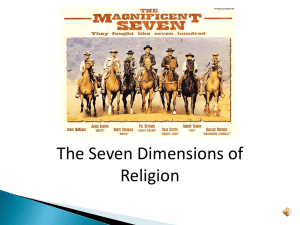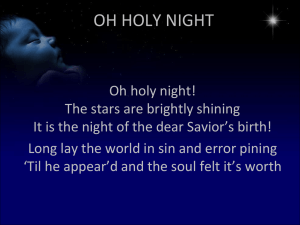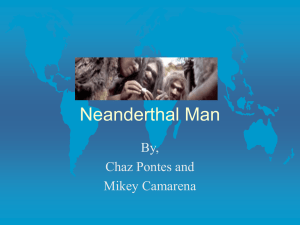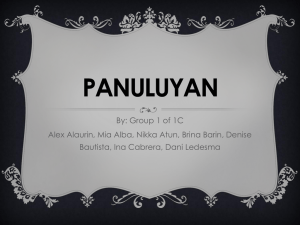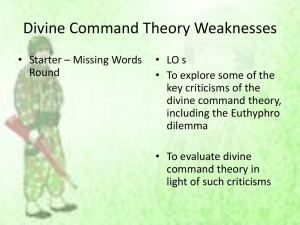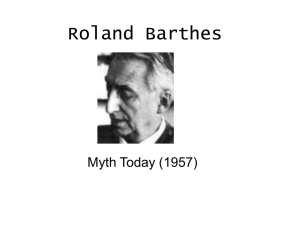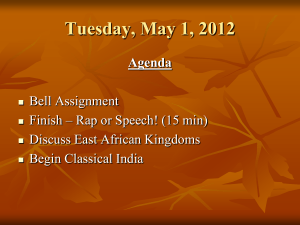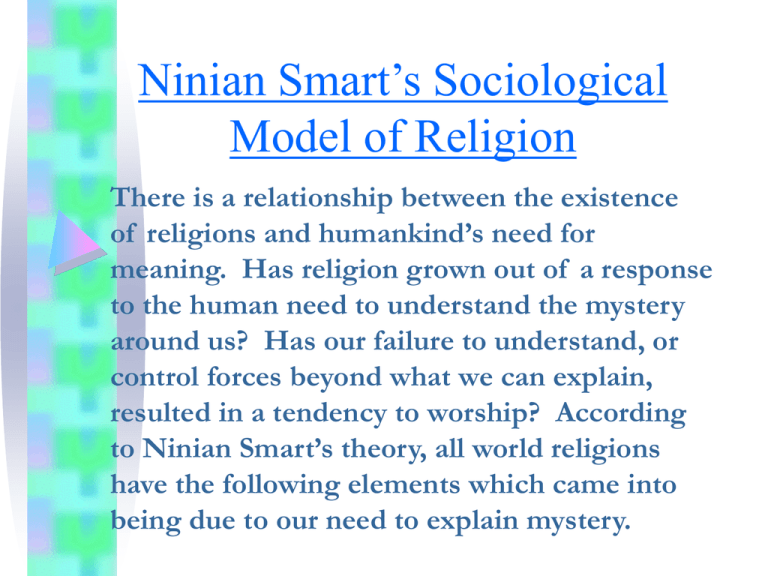
Ninian Smart’s Sociological
Model of Religion
There is a relationship between the existence
of religions and humankind’s need for
meaning. Has religion grown out of a response
to the human need to understand the mystery
around us? Has our failure to understand, or
control forces beyond what we can explain,
resulted in a tendency to worship? According
to Ninian Smart’s theory, all world religions
have the following elements which came into
being due to our need to explain mystery.
1. An Encounter with the
Divine
• All religions begin with an
experience of the divine. The
“divine” is that which gives meaning
to our existence. Someone has an
experience of a greater reality
which transforms that person and
our understanding of reality. This
person is the founder.
• Example: The disciples meet and
follow Jesus.
2. The Myth
The encounter with the divine is
remembered and retold, first in story
form and then in writing. An attempt is
made to communicate the experience.
Sacred books (scriptures) tell the story of
the founder’s religious experience.
Example:The disciples tell others about
Jesus. These stories later become
written down in the “gospels” or Bible.
• 3. Rituals (Cult)
• Attempts are made to recreate the
encounter with the divine using
ceremonies and celebrations.
• Example: For Catholics, the Mass is
an attempt to recreate the
experience of Jesus giving himself
for us at the Last Supper and on the
cross
• 4. Community
• People come together who share a
common vision of the world based
on their understanding of the
divine. In most religions, branches
or splits occur in the community as
a result of a variation in experience,
beliefs or world view.
• Example: The Catholic Church is
made up of local church
communities.
•5. Morality (Code)
•Members of the community
share a common set of
values which are rooted in
the experience of the divine.
These values determine right
and wrong.
•Example: Two Great
Commandments
•6. Beliefs (Creed)
•The community shares a
common vision of what the
world could be like based
on the encounter with the
divine.
•Example: The Christian
vision of the Kingdom of
God; The Apostle’s Creed
Charting Ninian Smart’s Six Trait
Model of Religion:
Religious Teaching or Doctrine (Creed)
creeds, laws, articles of faith
Community of Faith
Leaders and followers
Morality (Code)
Norms of behaviour, virtues, values, karma,
ethics
Religious Experience
Divine
God
gods
Spirits
angels
avatars
Demonic
satan
devils
evil spirits
Human
founders
mystics
prophets
Heirophanies
Encounters with
the sacred
Theophanies
Encounter with
God
Sacred Stories
Myths
Stories which explain sacred realities:
hero, creation, divine, natural
Scriptures
Sacred Writings containing myths, history,
law, wisdom, teachings, prophecy
Sacred Symbols and Rituals
(Cult)
Symbols (water)
Objects (rosary)
Places (shrines)
Clothing
Food
Prayer
Life-cycle rituals
Daily rituals
Weekly rituals
Pilgrimages
Annual festivals
Choice Self-test:
1.St. Luke writing his gospel:
a) religious experience b) myth c) ritual d)
community
e) beliefs f) code
2.The Catholic Catechism’s teaching on premarital sex:
a) religious experience b) myth c) ritual d)
community
e) beliefs f) code
3.Mohammed receiving a vision from the Angel
Gabriel:
a) religious experience b) myth c) ritual d)
community
e) beliefs f) code
4.Jewish wedding ceremony:
a) religious experience
b) myth c) ritual d)
community
e) beliefs f) code
5.Buddhists
a) religious experience
b) myth c) ritual d)
community
e) beliefs f) code
6.Jehovah’s witnesses state that only 144, 000 will be
saved at the end of time:
a) religious experience
b) myth c) ritual d)
community
e) beliefs f) code
7.The holy book of Islam called the Koran
a) religious experience
b) myth c) ritual d)
community
e) beliefs f) code
8. Face Mecca and pray five times a day:
a) religious experience
b) myth c) ritual d)
community
e) beliefs f) code
Neanderthal Man
The Neanderthal, was a species that inhabited
Europe and parts of western and central Asia.
Neanderthals had many adaptations to a cold
climate, such as large braincase, short, robust
builds, and rather large noses — traits selected by
nature in cold climates
Their cranial capacity was larger than modern
humans, indicating that their brains may have been
larger, which may be due to their more robust build.
On average, Neanderthal males stood about 1.65
m tall (just under 5' 5") and were heavily built with
robust bone structure.
Females were about 1.53 to 1.57 m tall (about 5'–
5'2").
Some physical characteristics
Projecting mid-face
Low, flat, elongated skull
Prominent browridge
Lack of a protruding chin
Broad, projecting nose
1200-1750 cm³ skull capacity
(10% greater than modern
human average)
Large round finger tips
Barrel-shaped rib cage
Large kneecaps
Long collar bones
Short, bowed shoulder blades
Thick, bowed shaft of the
thigh bones
Short shinbones and calf
bones
Culturally, Neanderthal was fully
human He buried his dead.
He drew paintings on cave walls.
He used fire and tools.
He played the flute.
He worshipped bears.
He was cannibalistic.
He cared for the injured and elderly.
In essence he did the things that other
humans have done down through
history.
In summary Neanderthal was more
muscular, more agile, and stronger
with a greater bone density than
modern humans.
He also had a bigger brain. He
would easily overpower most
modern day Homo sapiens. When
archeologists describe Neanderthal
they often use the word "robust."
This is a fancy way of saying bigger,
thicker or larger.
CRO-MAGNON MAN
Cro-Magnon man an ancestor of modern
man, Homo Sapiens Sapiens, living during
the last ice age in what is now Europe, most
notably in the area of modern day France.
Cro-Magnons knew how to make many
different tools and weapons, and wore sewn
clothes decorated with bone and shell
jewelry and ornaments.
They were taller and less muscular as their
cousin subspecies the Neanderthals that
originally habitated those colder regions.
It is named after the cave of Crô-Magnon in
southwest France, where the first specimen was
found.
They had a balanced diet of meat, grain,
wild carrot, beetroot, onion, turnip and other
foods.
Surviving Cro-Magnon artifacts include huts,
cave paintings, carvings and antler-tipped
spears. The remains of tools suggest that they
knew how to make woven clothing.
They had huts, constructed of rocks, clay,
bones, branches, and animal hide/fur.
These early humans used manganese and iron
oxides to paint pictures and may have created
the first calendar around 15,000 years ago
If Cro-Magnons buried their dead
intentionally it suggests they had a
knowledge of ritual, by burying
their dead with necklaces and
tools, or an idea of disease and
that the bodies needed to be
contained.
the humans of this time period
led a physically difficult life
The Cro-Magnons lived in Europe
between 35,000 and 10,000 years
ago. They are virtually identical to
modern man, being tall and
muscular and slightly more robust
on average than most modern
humans.
They were skilled hunters,
toolmakers and artists famous for
the cave art
most modern Europeans are
probably descended from them
Biologically modern human
beings (species Homo sapiens) first
appear about 120,000 years ago.
implements for making clothing,
engraving, and sculpting.
They produced fine artwork, in the
form of decorated tools, beads,
ivory carvings of humans and
animals, shell jewelry, clay figurines,
musical instruments, and
polychrome cave paintings of
exceptional vitality.
They were tall like
modern humans, their
skull had no brow
ridges, was thin,
rounded, with a high
forehead, with a
projecting chin.
Average brain
size:about 1,350
milliliters (same as
today).
As their oral anatomy
were identical to
modern humans, they
could probably
speak. They were our
ancestor.


